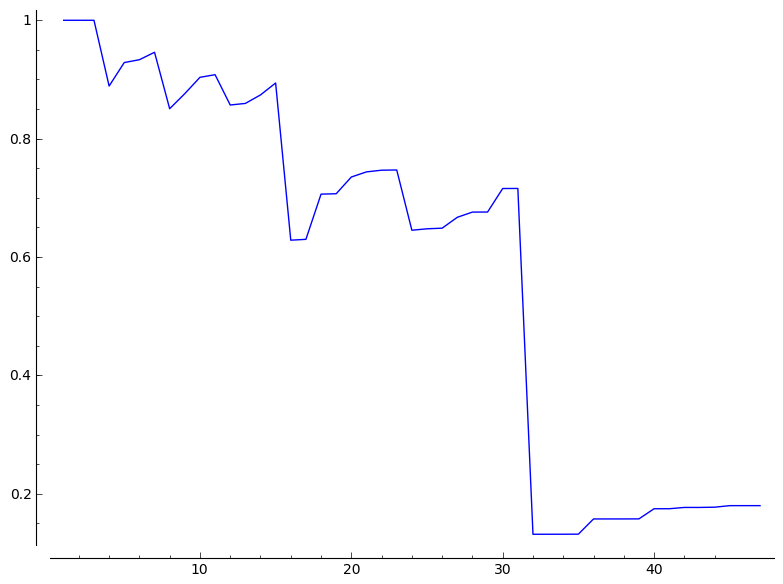Definition: Two inclusions of finite groups are equivalent, $(A \subset B) \sim (C \subset D)$, if: $(A/A_B \subset B/A_B) \simeq (C/C_D \subset D/C_D)$ with $A_B$ the normal core of $A$ in $B$.
Remark: The equivalence class of $(A \subset B)$ is the same that the conjugacy class of a transitive permutation group $G$ with $(A \subset B) \sim (G_1 \subset G)$.
GAP computation (the computation at index $\ge 32$ is due to Gordon Royle)
Up to equivalence, there are $3302368$ inclusions of finite groups $(A \subset B)$ of index $[B : A] \le 47$.
Among them, $593896$ have a distributive lattice $\mathcal{L}(A \subset B)$ of intermediate subgroups.
So the ratio with such a distributive lattice is less than $20 \%$.
Let $p_n$ be such a ratio for index $\le n$, let $\alpha_n = \liminf_{r>n} (p_r)$ and $\alpha = \lim_{n \to \infty} (\alpha_n) $.
Question: $\alpha = 0$ or $0< \alpha < 1/2$ or $\alpha \ge 1/2$?
Bonus: If $\alpha = 0$, what's its asymptotic analysis of $(\alpha_n)$?
Here is a graph for $p_n$ with $1 \le n \le 47$:

Here is the table giving at $T$ the number of transitive permutation group $G$ (up to conjugacy) of degree $n$, at $D$ the number with the lattice $\mathcal{L}(G_1 \subset G)$ distributive (with degree $ \ge 32$ due to Gordon), at $v$ the number of prime factors of $n$ and at $r$ an approximation of the ratio $D/T$:
$\scriptsize{ \begin{array}{c|c} n &1&2&3&4&5&6&7&8&9&10&11&12&13&14&15&16&17&18 \newline \hline T &1&1&2&5&5&16&7&50&34&45&8&301&9&63&104&1954&10&983 \newline \hline D &1&1&2&4&5&15&7&39&32&44&8&249&9&62&104&1055&10&894 \newline \hline v &0&1&1&2&1&2&1&3&2&2&1&3&1&2&2&4&1&3 \newline \hline r &1 &1 &1 &0.8 &1 &0.94 &1 &0.78 &0.94 &0.98 &1 &0.83 & 1 & 0.98 &1 &0.54 &1 &0.91 \end{array} } $
$\scriptsize{ \begin{array}{c|c} n & 19&20&21&22&23&24&25&26&27&28&29&30&31&32& 33 \newline \hline T &8&1117&164&59&7&25000&211&96&2392&1854&8&5712&11&2801324&162 \newline \hline D &8&923&163&58&7&15627&208&95&2151&1541&8&5461&11&344731&162 \newline \hline v &1&3&2&2&1&4&2&2&3&3&1&3&1&5&2 \newline \hline r &1 &0.83 &0.99 &0.98 &1 &0.62 &0.99 &0.99 &0.90 & 0.83 &1 &0.96 &1 &0.12 &1 \end{array} }$
$\scriptsize{ \begin{array}{c|c} n &34&35&36&37&38&39&40&41&42&43&44&45&46&47 \newline \hline T &115&407&121279&11&76&306&315842&10&9491&10&2113&10923&56&6 \newline \hline D &114&407&92110&11&75&305&105948&10&8842&10&1762&10546&55&6 \newline \hline v &2&2&4&1&2&2&4&1&3&1&3&3&2&1 \newline \hline r &0 .99 & 1 &0.76 &1 &0.99 &1 &0.34 &1 &0.93 &1 &0.83 &0.97 &0.98 &1 \end{array} }$
Remark-questions: we observe on this table that $r\ge 0.78$ if $v \le 3$. Is it true in general?
More generally, $\forall m$, is there $\alpha_m>0$ such that $r \ge \alpha_m$ if $v \le m$?
